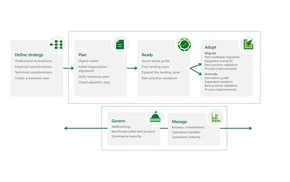Azure Landing Zone Design Principles
You want to design your cloud environment to be capable of innovation and transformation, while keeping the environment secure and compliant by default. For this purpose, the CAF uses the Azure Landing Zone Design Principles.
In total, there are 5 Design Principles:
1 Subsciption democratisation
Subscriptions are used as a unit of management and scale, tailored to your business needs and priorities. This allows you to support portfolio owners in accelerating application migrations and the development of new applications. You can also manage rights at the subscription level, such as role-based access control (RBAC). You apply subscriptions per solution, guaranteeing the management of this application within the subscription. It also delineates governance. Subscriptions are also a useful tool in separating development and production with other governance guidelines. You can read all about it here.
2 Policy driven governance
The right Azure policies ensure the compliancy of your cloud platform, while providing the developer and end user as guard-rails with enough freedom to do their jobs properly. Want to know more about policy driven cloud governance? You can read it in our article Policy driven governance: guardrails for cloud.
3 Single control and management plane
By implementing the CAF, you ensure management from one central location, so that your cloud environment offers a consistent experience for both AppOps and DevOps. You do this by avoiding abstraction-layer dependencies in your landing zone architecture. For example, specifically developed portals or tooling.
4 Application centric and archetype neutral
With an application centric service model, you focus on application oriented migrations and development instead of pure infrastructure migrations (lift-and-shift migrations), such as moving virtual machines. Design choices should not distinguish between old and new applications and infrastructure as a service (IaaS) or platform as a service (PaaS) applications. In doing so, you strive for a secure environment for all your applications in the cloud.
5 Azure native design and platform roadmap alignment
The Cloud Adoption Framework only uses Azure-native platform services where possible, so that new features that become available can be used immediately within your cloud environment. Azure platform services also help you create your migration strategy. Align your solution, system or software application with Azure native design and roadmap. This keeps your solutions up-to-date using the newest Azure functionalities and creates a seamless collaboration with the Azure cloud computing platform. Therefore, keeping your environment safe, scalable, reliable and cost efficient.




